Sweep Picking Easy Beginner's Guide: The 5-Part Quick-Start Strategy
Make this incredible technique effortless...

Why do so many people struggle with sweep picking?
It seems simple, yet it can take years to master. But what if you could get it down FAST?
That's why I've written this article - to help you learn sweep picking. You're gonna learn the technique , the practice process (this is HUGELY important, but most people miss it!) and some super-cool licks that anyone can get fast. Even if you'd never heard of the technique until now,
you're gonna learn some really cool stuff that'll spice up your solos.
Click Here to download the PDF and audio files of the licks in this lesson.
What Is Sweep Picking?
Sweep picking, popularised by Yngwie Malmsteen in the 1980's, is a technique used to play fast runs that go across lots of strings at once.
To pick fast, guitar players normally use "alternate picking", where you pick one stroke down, then one stroke up, then one down, one up, and so on. You alternate between down and up strokes so that you can play faster than if you just did one or the other.
This is great for things like this: (Click to open in new tab to zoom)
But what if you had to play this?
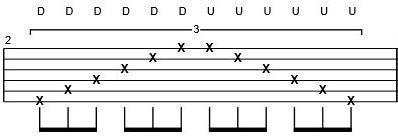
It'd be really awkward to alternate pick that! You'd be much better off doing one "down-pick" (like lots of down picks all one after another) and then one "up-pick" across all the strings, a bit like a controlled strum.
That's called a "sweep" - where you sweep your pick across the strings in a controlled way, to play lots of notes on consecutive strings.
People often use sweep picking to play arpeggios (the notes of a chord played separately) with one note on each string, but there's lots more you can do with it - as you'll find out in this lesson.
Sweep picking is just a way to change strings. You just do one long motion across the strings to pick them quickly one after another.
1: The Technique
We'll start by learning the basics of the technique. I'll give you a few exercises to help learn the motion.
Start with this exercise:
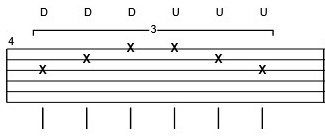
Gently rest your left hand on the strings, so you get a muted sound with each pick stroke. This allows you to completely focus on the picking motion.
Do down strokes from the G string to the high E string, and then turn around and do upstrokes back up again.
You should do one long, smooth stroke to sweep, and not lots of separate motions. It's ONE smooth movement across lots of strings. Holding your pick with a fairly relaxed grip will help you to sweep smoothly. Remember to stay perfectly in time - play slowly and make sure the gap between each note you play is identical.
At first just get used to the motion, and then try it slowly with a metronome to test that you can do it while staying in time. You don't have to do it fast (and you shouldn't
do it fast yet) - control is the goal here.
Lots of people ask about the precise picking motion you should use - which muscles and so on. Generally it doesn't matter (your practice approach, exercises and mindset make far more difference), but here is a picture of the way I hold the pick and sweep:
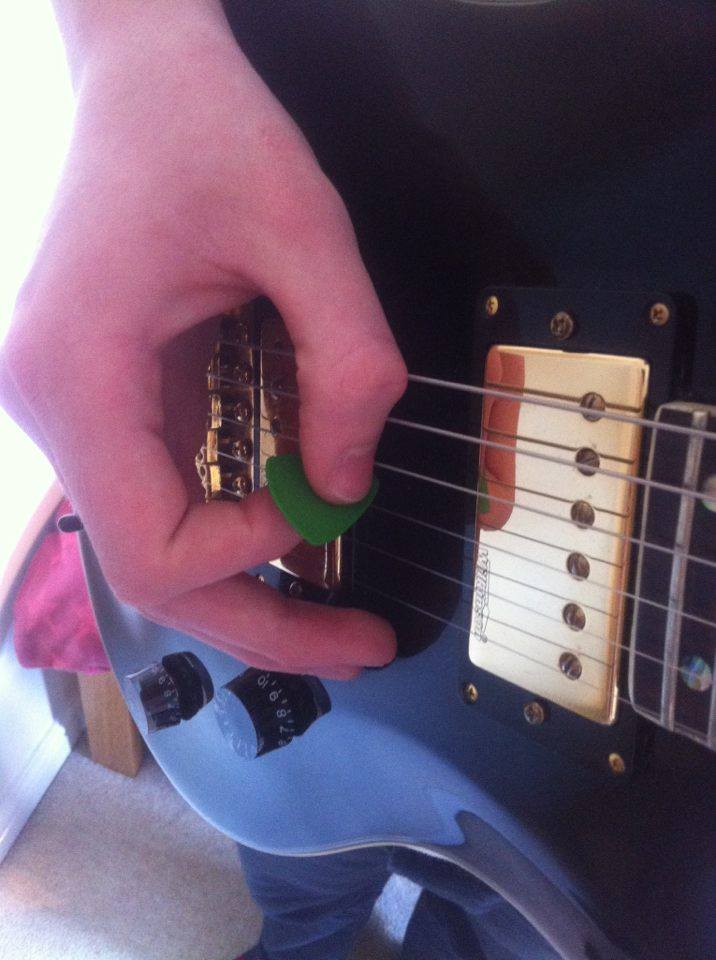
In general just use whichever motion you feel comfortable with. Just one piece of advice - the larger the muscle group you use, the harder it will be to control the motion and get a clean sound. Sure, some of the pro's use large arm motions to sweep, but they succeed DESPITE this, not BECAUSE of it. I personally use a combination of finger and wrist to move my pick because it gives me lots of control. Use whatever feels easiest to you.
Here's another exercise. This one is on two strings, and it'll help you get used to changing direction at the bottom/top of sweeping patterns. Mute the strings with your left hand again, and remember to focus on perfect timing. The picking is Down, Down, Up, Up.
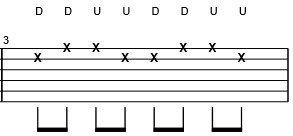
2: The MAIN Challenge Of Sweep Picking
So many people get this wrong, and it completely sabotages their progress.
Ask most people what the main challenge with sweeping is, and they'd say "trying to synchronise the hands together". This basically means making sure you pick the notes at exactly the same time that you fret them, because otherwise the notes won't come out clearly.
But what if that wasn't the challenge at all? What if there was something deeper going on?
Well, there is. Trouble synchronising the hands isn't the problem itself, it's a symptom
of a problem. It's a symptom of not playing in time.
Timing is a huge part of sweep picking well. It can be difficult because unlike alternate picking where each pick stroke is a separate motion, we have this long, gradual movement across all the strings where multiple notes are played with one movement.
But timing is absolutely vital
to being able to sweep well! If you can't play in time then you won't be able to synchronise your hands and instead of hearing an awesome, lightning-fast lick, you'll just hear a bunch of rubbish noise. Not what we want!
So how do you get perfect timing?

It all comes down to a nice little trick. I said earlier that you should do one long movement to sweep; that's kind of true, but not completely.
When you play fast that's exactly what you're doing, but when you practice slow you should do something different. Don't do one indefinable movement that's difficult to control - instead, do separate movements!
I said do one long motion before so that if you've never done sweeping before you can get used to the feeling, but when you've got the basic idea you should practice with separate movements.
Now I know what you're thinking: "This is BS! Everyone says NOT to do separate movements". That's what I thought, until I decided to try this new approach. Test it out for two weeks and see what results you get - you'd be surprised!
There's a special way of doing it I want you to follow, though - it's not just doing separate strokes as normal.
When you play each note, pluck it and then immediately "follow through", resting your pick on the next string to be played. Then, keep it there until the time comes to play the next note.
The motion is almost like a "rake" - you rake through one string and rest the pick on the next string, before plucking that and then resting on the next string, and so on. The following exercise is good to practice it (mute the strings with your left hand again):

Here are some photos showing the stages of the motion. Here I am resting my pick on the G string, ready to pluck it:
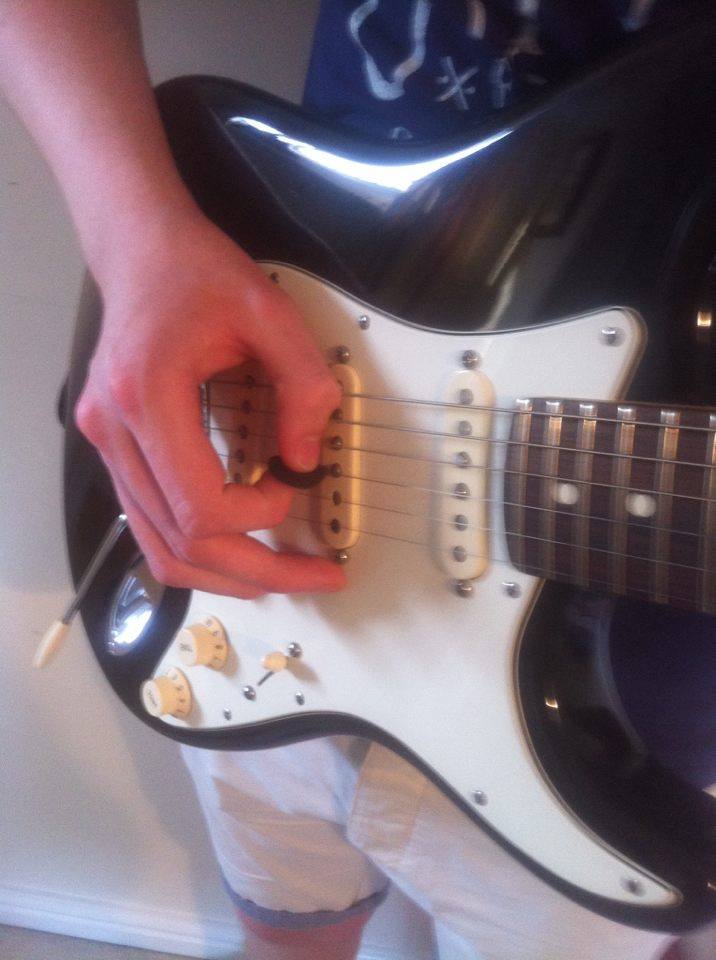
In one motion I pick the G string and then follow through to rest my pick on the B string.
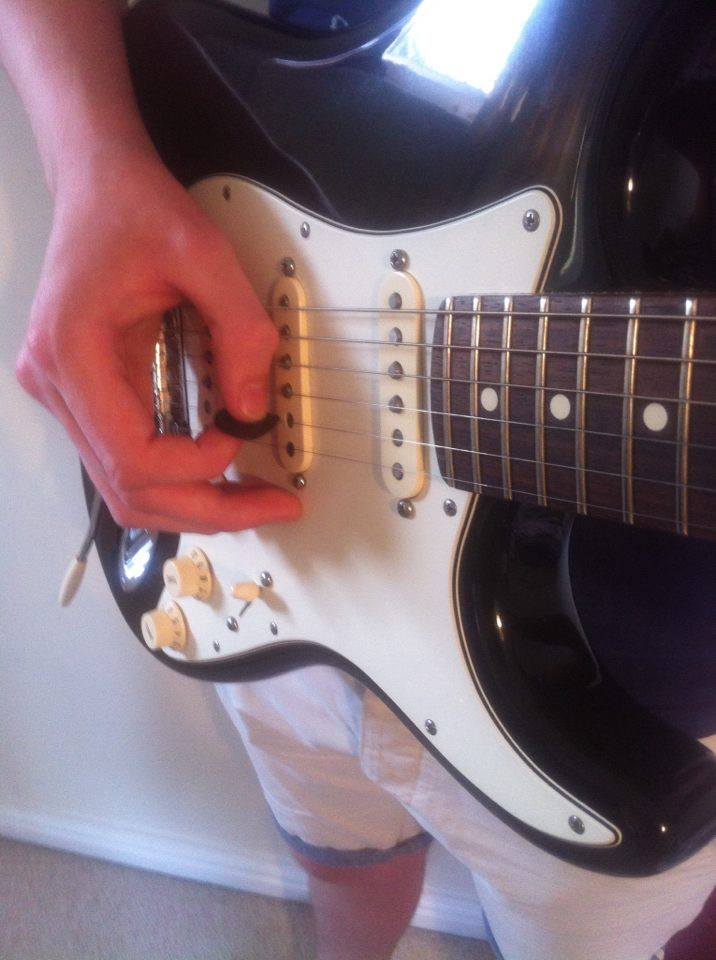
Then, I pick the B string and continue the downward motion to rest my pick on the high E string:
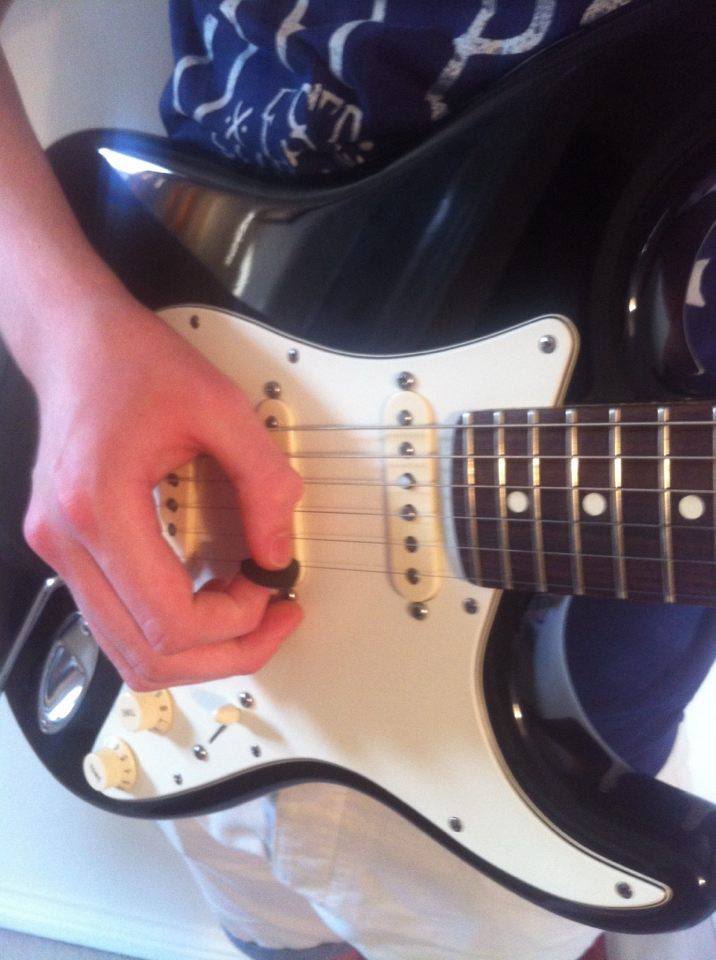
I then pick the high E string before doing the same thing on the way back up, as shown by these photos:
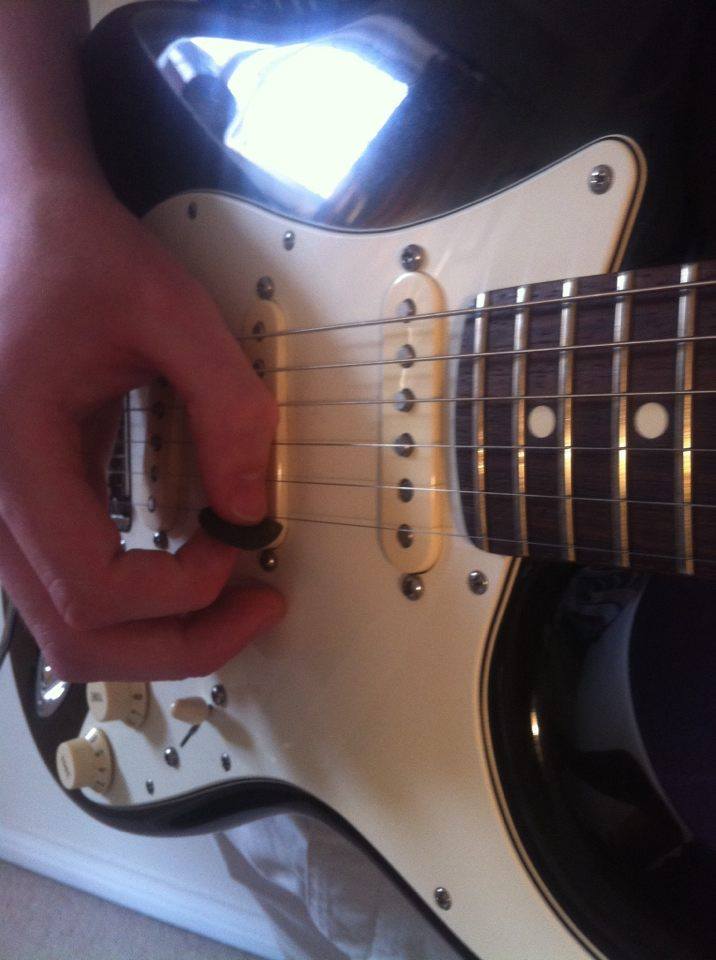
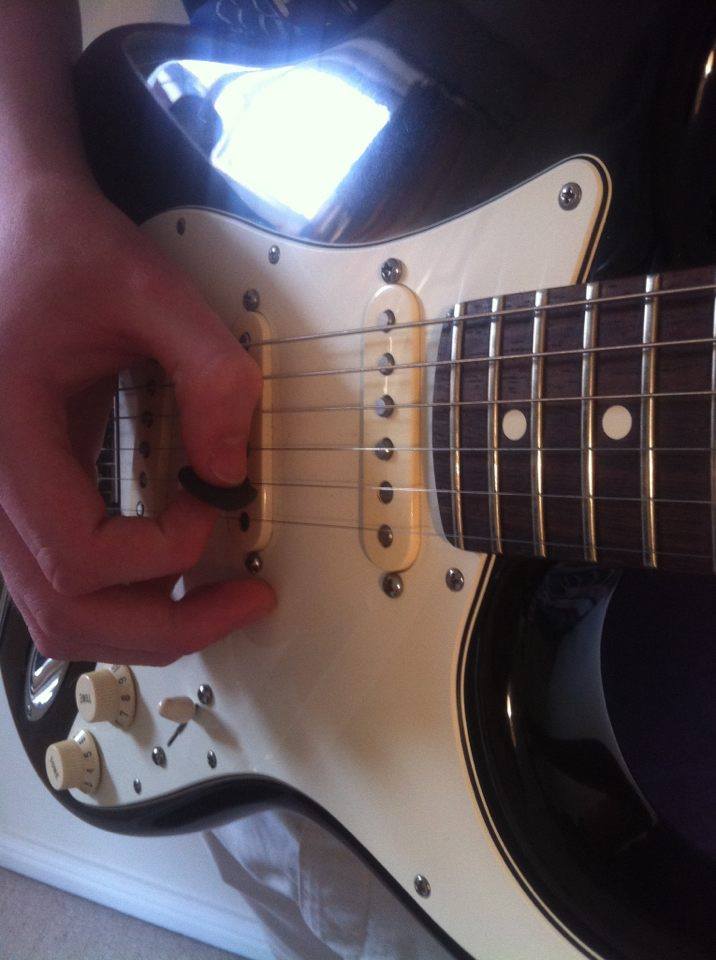
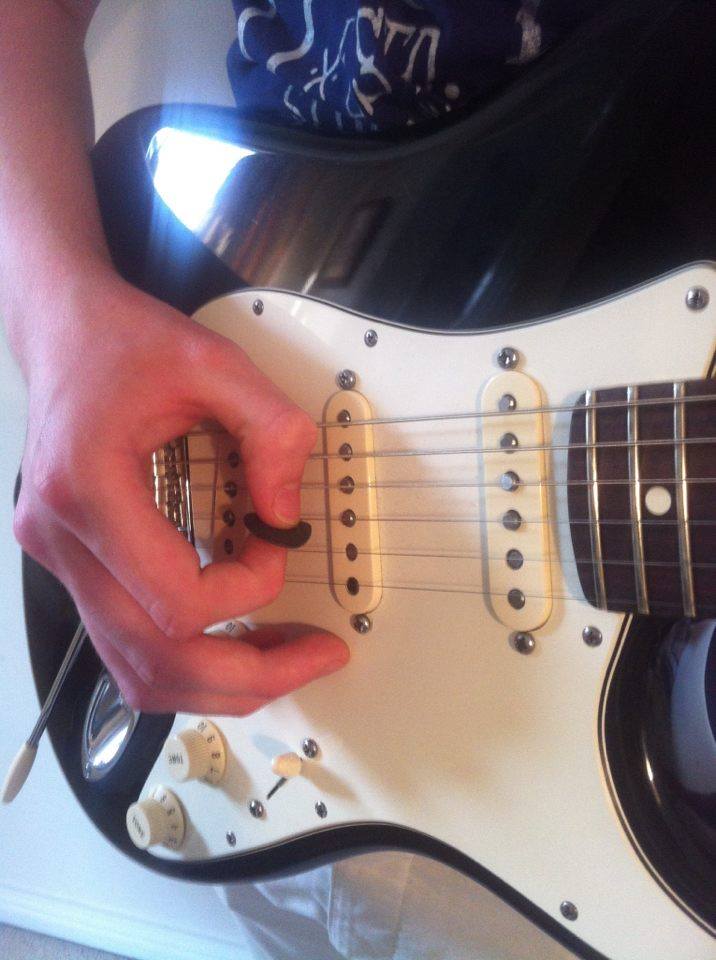
Do that exercise for a little while just to get used to the technique. Use this whenever you practice a sweep picking pattern slowly - it really is the key to mastering your timing, and sweep picking as a whole.
This motion is easily controllable and as you speed up you'll find that timing isn't an issue. The motion automatically becomes a smooth, fast sweep when you increase the tempo, but it's still completely controlled and really accurate.
It also helps to keep your motions small, so you'll be able to play even faster. Awesome!
3. Step-By-Step Mastery
Before we get on to the licks, I'm gonna show you how to practice them.
This is SO important, but barely anyone talks about it! They say "oh, just repeat it slowly and speed up" and although that's true, there's more to it than that.
1) Learn The Notes
Read the tab as you play slowly, and learn the notes of the lick. Practice it until you can play it slowly without having to refer to the tablature.
2) Play It Effortlessly
Now I want you to sit down with your guitar and play the lick EXTREMELY slowly. I mean really
slow! One note every few seconds. Don't use a metronome yet.
Don't just wait in between the notes, though - concentrate on making every movement perfect. The three areas you should focus on are:
RELAXATION:
Is your body completely relaxed? Make sure you're only using the minimum force required to hit the notes. Go through the different parts of your body like your fingers, lower arms, upper arms, back, etc. and make sure that they aren't tense. Tension will not only kill your speed but also increase risk of injury.
EFFICIENCY:
Make your movements as small as possible. Extra movement will just slow you down. Remember to use the follow-through picking technique described above; it'll help you to control the size of your motions.
SYNCHRONISATION:
When you're playing this
slow timing doesn't really come into it, but you should still sync your hands up perfectly. When you pick a note, make sure you fret it at exactly the same time. There shouldn't be any "noise" or empty gap between one note ringing out and the next one being picked; they should flow together evenly.
The whole idea of this is to play the notes PERFECTLY - the better you do this, the easier everything else will be later. Do it for around 5-10 minutes before moving on.

3) Build It Up
Now it's time to get out your metronome.
Set the tempo for 60 beats per minute and play one note for every four beats, focusing on playing perfectly.
After a couple of minutes, play one note for every two beats. Then, after a while increase it to one note for every click of the metronome.
Build up to two notes per beat at 60bpm, and then four (16th notes). If you're playing a triplet lick then build up to three notes per beat at 60bpm, instead of four.
Make sure to focus completely when you do this - it should take around 20 minutes to go from the super slow one-note-in-four-beats tempo to four-notes-in-one-beat tempo.
We start so slowly to make sure you use perfect technique. FOCUS, and try to play it exactly right (efficient, relaxed and synchronised) every time.
4) Reach Hyper-speed
This is where it gets really fun! The previous three stages are VITAL, though, so don't move on until you've completed them.
By now you should be able to play the lick without thinking. If not, do more of stages 1, 2 and 3 until you can.
When the lick is subconscious - when your fingers play it without you having to tell them which notes to hit - the only thing between you and hyper-speed is repetition.
The good thing is that we don't have to concentrate any more because it's automatic. This means we can repeat it while watching TV, talking to friends or watching YouTube videos.
The key to playing fast is to do lots of perfect repetitions. By this point we've got it perfect so the only thing left is to repeat it lots of times, while entertaining ourselves with other things.
This makes building insane speed really easy
, because it doesn't even feel like work. It's fun!
If, like me, you spend an hour or so a day watching YouTube videos (like documentaries or something - longer videos are better), then play your guitar at the same time! Pick one sweeping lick and repeat it on autopilot while you watch. It's a great way to get loads of extra practice time in without making sacrifices.
Do this whenever you can - every day - and you can do hours of practice without noticing the time going by. It's an AWESOME practice strategy for speeding up your licks.
4. Easy and Awesome Licks
All the licks in this section build on the previous ones, so start at the beginning and continue from there. Master each stage before moving on; pick ONE lick and use the practice approach above to conquer it. Focus on one thing until you absolutely master it - you'll learn way faster than if you try to learn everything at once.
CLICK HERE
to grab the audio and PDF for the licks.
The first one is more of an exercise than a lick, but it's a part of almost every sweeping lick you'll find - hammering on and pulling off with the little finger. Concentrate on getting a clear note and remember to stay as relaxed as possible.
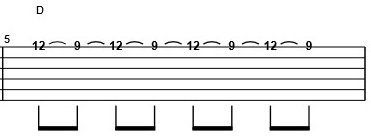
Next we're gonna do two string sweeps - the first one is an A major arpeggio with the root on the B string. The picking is down, down, up, pull-off. These are pretty easy to learn and they sound awesome!
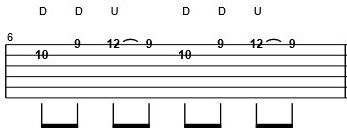
The next one is a B minor arpeggio. If you've learned the last one then this'll be no problem, because the picking and fingering are the same.
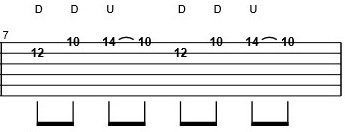
Now we've got a "major" two-string arpeggio and a "minor" two string arpeggio. This means we can make some cool etudes and sequences with them!
This one goes A minor, G major, F major, E major. It sounds quite classical/baroque. (Click on image to enlarge)
Now we're gonna move on to the three-string sweeps. These are really fun, and if you've mastered the two-string patterns then they're pretty simple. The first one is pretty easy; the picking is down, down, down, up, up, up. It's an A minor 7th arpeggio.
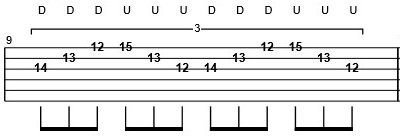
The next one is also A minor seventh, but it's a 16th note lick rather than a triplet one. The picking is down, hammer-on, down, down, up, pull-off, up, up. You'll notice that it's got the two-string sweep pattern in there - that's why we learned the two string pattern first.
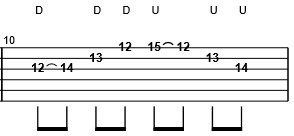
The next lick is one of my favourites. Make sure you've mastered the previous one before trying it! It's an A minor 7th arpeggio again, but the notes at the top of the arpeggio are repeated to create a really cool sound. Pay close attention to the picking directions, and make sure you use exactly the same motions each time - the picking is where you're most likely to mess up here.
Now we have another A minor 7th arpeggio. This one has the same picking as one of the other licks above which makes it pretty easy to learn.
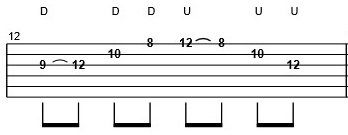
Here is a diminished 7th arpeggio. Every note in the arpeggio is three frets away from the next, meaning that any of the notes could be the root. This example could be a C, Eb, Gb or A dim7 arpeggio.
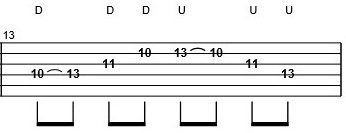
5. Complete Mastery
To master something on guitar, you don't just need to know how to play it - you need to know how to USE it.
If you don't integrate it with what you already know then it's useless! You're never gonna put it to use in REAL MUSIC.
After all, that's the goal here - music. Not some cheap fancy trick, but a new musical tool we can use to express ourselves.
That's why I developed these two strategies to integrate these awesome licks with everything else you know:
1. Create Combo Licks
This is a killer way of integrating new material with your current skills.
Essentially, you create easy ways to go into and out of the new lick using things you already know.
If I'm already great at tapping (for instance), and use it in my solos all the time, then I'll create some licks that combine the new sweeping patterns with tapping.
That way whenever I do tapping in a solo, it's easy to go into the sweeping in a natural way.
This is an example lick that combines a new sweeping pattern with some tapping:
Let's do another one. Say I already know some pentatonic blues licks but I wanna combine them with sweeping. I could take a basic blues lick like this:
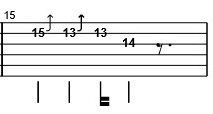
And a sweep in the same position:

And then combine them:
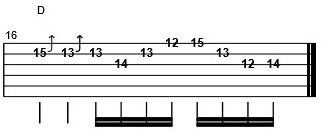
That way whenever I play that basic blues lick, I can go straight into the cool sweep picking pattern in a way that sounds cool and natural. The blues lick finishes on the same note that the sweep starts on too, which makes it even easier.
Do this every day and before you know it sweeping will be second nature.
2. Improvise
If you don't already improvise to backing tracks, do it! It's one of the best things you can do for your guitar playing.
(Find 38 free backing tracks right here)
For every half hour you spend practising technique (in the way above), you should spend 15 minutes improvising.
When you improvise, deliberately use the lick you're practising even if it doesn't sound that great. It'll sound awkward at first because you're using something new, but stick with it and soon it'll be a natural part of your style.
Use the combo licks you created earlier, too - they are a great "middle ground" between never having used the lick and using it naturally in improvising.
So how do you get started? Well, you grab a backing track (from the link above) in the key of the lick you're learning. Start to play to it and deliberately use the lick as part of your solo. It doesn't matter if it sounds really disjointed and weird - that's gonna happen at first!
Then, keep doing it. Find new, easy ways to go in and out of the sweeps. The trick here is making it easy for yourself - don't go after something too complex at first. Keep it simple!
The more you improvise like this, the more natural the sweeps will become. Use these two strategies regularly and sweep picking will be a normal part of your style.
You'll be one of the few players who can improvise with amazing-sounding shred licks and make it musical - which will put you FAR ahead of the usual "shreds but can't play real music" crowd.
Final Thoughts
There you have it - a super easy method to get started with sweeping. There's loads more - five string shapes, six string shapes, sweeping scales, creating etudes, extended chords... the sky is the limit!
This article has given you the ideal foundation for killer sweeping technique. Whatever you wanna learn, you've now got the skills and knowledge to do it!
Oh, and don't forget to download the free mp3 and PDF files of the licks right here
, to use when you practice.
Have fun, and keep rocking!




